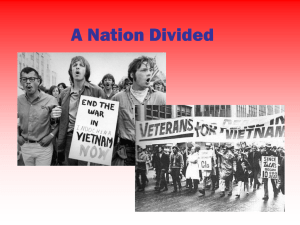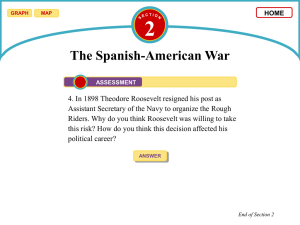Enduring Themes Event Cards
advertisement
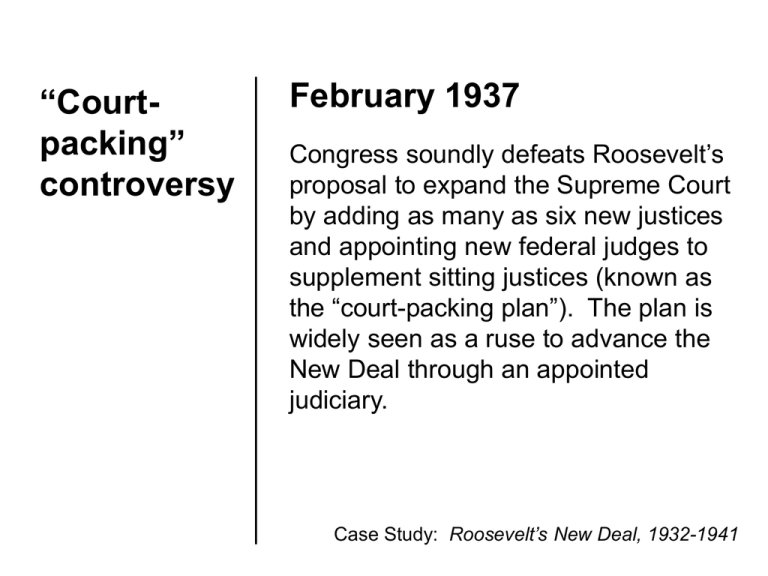
“Courtpacking” controversy February 1937 Congress soundly defeats Roosevelt’s proposal to expand the Supreme Court by adding as many as six new justices and appointing new federal judges to supplement sitting justices (known as the “court-packing plan”). The plan is widely seen as a ruse to advance the New Deal through an appointed judiciary. Case Study: Roosevelt’s New Deal, 1932-1941 Social Security Act Passed August 14, 1935 The Social Security Act establishes pensions for retirees, as well as unemployment insurance and benefits for children and the handicapped. Social Security is paid for by payroll taxes. Case Study: Roosevelt’s New Deal, 1932-1941 “Four Freedoms” Speech January 6, 1941 In his State of the Union message, Roosevelt spells out four essential freedoms that distinguish democratic governments from the fascist states promulgating war in Europe: freedom of speech, freedom of religion, freedom from want, and freedom from fear. Case Study: Roosevelt’s New Deal, 1932-1941 Women in the workplace December 1944 At its peak, about six million women enter the wartime workforce. During the war, women make up about a quarter of the workplace in the automobile industry, and nearly half in electrical manufacturing. “Rosie the Riveter” (immortalized in a popular song of the day) becomes a symbol of women’s contribution to wartime productivity. Case Study: America Goes to War, 1939-1945 America First Committee organized September 1, 1940 A coalition of lawmakers and businessmen from the America First Committee, characterizing World War II as a “European War.” Before the attack on Pearl Harbor, the committee has about 450 local chapters. Admired public figures such as Charles Lindbergh are at the forefront of the isolationist movement. Case Study: World War II, 1933-1945 Atomic bomb detonated over Nagasaki August 9, 1945 The U.S. Air Force drops an atomic bomb over Nagasaki; the plutonium bomb (nicknamed “Fat Man”) has a greater force than the uranium bomb used in the mission over the Hiroshima. Deaths from the initial blast are about 40,000; an equal number are estimated to have perished from burns, injuries, and exposure to radiation. Case Study: World War II, 1933-1945 “Code Talkers” enlisted May 1942 Twenty-nine “code talkers,” Navajo men enlisted to transmit secret information over radios in their native language, begin boot camp. About four hundred Navajo code talkers serve as marines, while the army enlists Choctaws and Comanches. Their language baffles Japanese codebreakers and helps win such key battles as two Jima. Case Study: World War II, 1933-1945 United Nations charter ratified October 24, 1945 Like its predecessor, the League of Nations, the United Nations is founded on the principles of international cooperation and peace. The United States takes a major role in the United Nations, headquartered in New York. Case Study: World War II, 1933-1945 SS St. Louis May-June, 1939 On board the SS St. Louis, 937 German refugees from the Nazi regime are turned away from both Cuba and the United States. In June, groups of refugees find sanctuary in the Netherlands, France, Great Britain, and Belgium. Case Study: Holocaust and Genocide, 1939- Present Nuremberg Trials convene November 20, 1945 Twenty-four former Nazi officials are brought to trial in Nuremburg under international law for war crimes and “crimes against humanity.” The unprecedented trials conclude on October 1, 1948; twenty-one officials are found guilty and either imprisoned or executed, and one is acquitted. Case Study: Holocaust and Genocide, 1939- Present Steel Seizure Case June 2, 1952 In April 1952, President Truman ordered the seizure and takeover of steel mills in anticipation of a labor strike that could possibly harm the defense industry during the Korean War. In the resulting Supreme Court case Youngstown Sheet and Tube Co. v. Sawyer, the Court rules that the president has no such power over private property. Case Study: The Cold War Begins, 1945-1960 Declaration of Conscience June 1, 1950 The opposition to Senator McCarthy’s relentless Communist-hunting includes Senator Margaret Chase Smith’s Declaration of Conscience on the Senate floor in 1950. Her speech chastises those who resort to implications and “character assassinations” in senate hearings. Case Study: The Cold War Begins, 1945-1960 Interstate Highway Act June 29, 1956 President Eisenhower signs the interstate Highway Act, initiating the most extensive public works projec tin U.S. history. Federal and state governments plan to build 42,000 miles of highway at a cost of $27 billion. The system is designed to accommodate the movement of military troops and equipment, while linking urban and rural areas. Case Study: Suburbia, 1945-1965 Suburbs and “white flight” December 1960 The continuing move to the suburbs demonstrates overall U.S. economic growth while exposing ongoing class and race divisions. Studies show a “white flight” of middle-class whites away from many American cities. Consequently, the lower tax bases in cities lead to fewer services and improvements in urban areas. Case Study: Suburbia, 1945-1965 “A Vast Wasteland” May 9, 1961 Addressing a convention of broadcasters, Federal Communications Commission chairman Newton Minow blasts television programming as “a vast wasteland.” Similar critics of television view the medium as advertisement-driven and fixated on mindless entertainment, rather than serving the public interest. Case Study: Suburbia, 1945-1965 Desegregation of the U.S. military July 26, 1948 Due in large part to the contributions made by African Americans to war effort, abroad and at home (where over two million African Americans were employed in defense-related industries), President Harry S. Truman officially desegregates the military. Case Study: The Civil Rights Movement, 1948-1968 Brown v. Board of Education May 17, 1954 Future justice Thurgood Marshall successfully argues to the U.S. Supreme Court that the 1896 ruling of Plessy v. Ferguson is unconstitutional. The Court unanimously rules that segregated schools are “inherently unequal.” Case Study: The Civil Rights Movement, 1948-1968 “Massive resistance” February 24, 1956 A coalition of white southern congressmen calls for massive resistance to the Supreme Court’s desegregation rulings. Case Study: The Civil Rights Movement, 1948-1968 “Letter from Birmingham Jail” April 1963 Arrested for protesting segregation, Dr. Martin Luther King, Jr., writes “Letter from Birmingham Jail,” a statement of principal civil disobedience, during his eight-day prison stay. In May students in Birmingham respond with the Children’s March to protest his incarceration. Case Study: The Civil Rights Movement, 1948-1968 Loving v. Virginia June 12, 1967 The U.S. Supreme Court strikes down a Virginia law banning interracial marriage in the case of Loving v. Virginia. The Court unanimously rules that any such law passed by a state violates citizens’ Equal Protection rights under the Fourteenth Amendment. Case Study: The Civil Rights Movement, 1948-1968 Voting Rights Act signed August 6, 1965 President Johnson signs the Voting Rights Act into law, outlawing literacy requirements for voting and enforcing equal opportunities to vote. Case Study: The Civil Rights Movement, 1948-1968 Civil Rights Act of 1964 July 2, 1964 Congress passes the sweeping Civil Rights Act of 1964, setting the stage for desegregating schools, banning discrimination in public accommodation and businesses, and creating the Equal Employment Opportunity Commission. Case Study: The Civil Rights Movement, 1948-1968 Freedom Summer Begins June 1964 The Congress of Racial Equality (CORE), an interracial civil rights group, launches Freedom Summer, an effort to register black voters in Mississippi. CORE members often face violent opposition during their campaign. Case Study: Civil Rights at a Crossroads, 1968-1979 Bus controversy begins in Boston August 1965 A new Massachusetts law requires Boston public schools to achieve racial balance in their schools or give up state funding. Backlash grows among those anticipating “forced busing.” Boston becomes the site of the nation’s most contentious battles over busing in the 1960s and 1970s. Case Study: Civil Rights at a Crossroads, 1968-1979 Black Panthers form October 1966 The Black Panther Party forms in Oakland, California, founded by Huey Newton and Bobby Seale. The Black Panthers’ stated intention is to promote black self-defense. At their peak, the Black Panthers boast about two thousand members and sponsor educational free-food programs in inner cities. Case Study: Civil Rights at a Crossroads, 1968-1979 “Black power” salute at Olympics October 17, 1968 At the Olympics in Mexico City, U.S. track-and field athletes Tommie Smith and John Carlos raise their fists in a “Black Power” salute as the National Anthem plays during the medals ceremony. The two athletes are expelled from the Games for their protest. Case Study: Civil Rights at a Crossroads, 1968-1979 National Defense Education Act September 2, 1958 Congress passes the National Defense Education Act, which increases funding for training in mathematics and science. The act is designed to keep the United States competitive engineering. Case Study: Kennedy & the Communist Threat,1957-2004 Bay of Pigs invasion April 17, 1961 CIA-trained Cuban exiles attempt to overthrow the Castro regime, landing at two beaches on the Bay of Pigs. The Cuban army puts down the rebellion by April 19. The failure of the invasion is an embarrassment to the Kennedy administration. Case Study: Kennedy & the Communist Threat,1957-2004 Gulf of Tonkin incident August 2, 1964 The USS Maddox is attacked with torpedoes while conducting surveillance in the Gulf of Tonkin, thirty miles off the North Vietnamese coast. President Johnson orders air strikes in retaliation, and seeks wider military powers from Congress. Case Study: The Vietnam War , 1950-1979 Antiwar protest at Pentagon October 21, 1967 Thirty-five thousand people gather at the Pentagon to protest the war. By the end of the year, for the first time, a majority of Americans believe the commitment of U.S. troops in Vietnam was a mistake. Case Study: The Vietnam War , 1950-1979 “Secret” bombing of Cambodia begins March 1969 The United States begins an extensive bombing campaign in Cambodia, with the aim of stopping the influx of supplies and reinforcements to North Vietnam. The American public is left uninformed of these actions. Case Study: The Vietnam War , 1950-1979 “Pentagon Papers” released June 13, 1971 The New York Times begins the publication of leaked documents concerning the Vietnam War. The classified “Pentagon Papers” are leaked by Daniel Elisberg, a government research associate who opposes the war. Though largely an expose of the past actions, the Pentagon Papers fuel criticism of Nixon’s current handling of the war. Case Study: The Vietnam War , 1950-1979
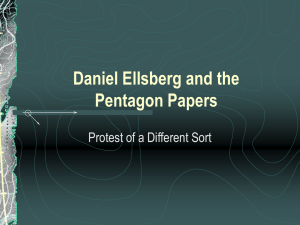
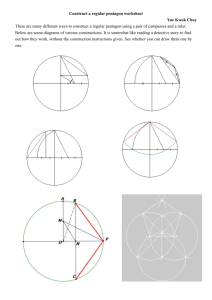

![vietnam[1].](http://s2.studylib.net/store/data/005329784_1-42b2e9fc4f7c73463c31fd4de82c4fa3-300x300.png)


